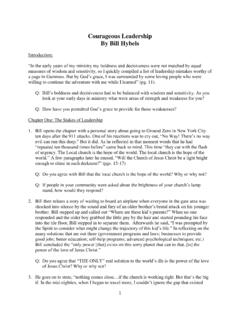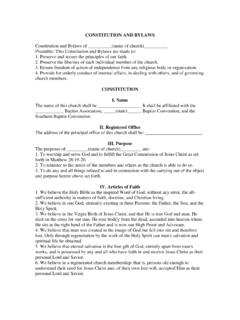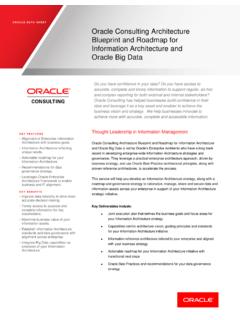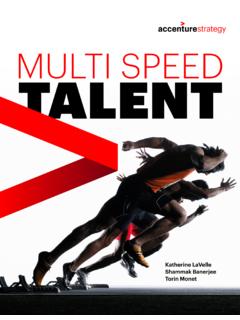Transcription of BOUNDARIES FOR LEADERS By Henry Cloud
1 1 BOUNDARIES FOR LEADERS By Henry Cloud Preface: LEADERS lead people, and it is the people who get it all done. And to get it done, they have to be led in a way that they can actually perform, and use all their horsepower. Said another way, their brains need to work. You can cast a great vision, get the right talent, and yet be leading in ways that people s brains literally cannot follow, or sometimes even make work, much less their hearts. What I have come to believe is this: while leadership as a discipline is very, very important, the personal and interpersonal sides of leadership are every bit as important as the great leadership themes of vision, execution, strategy, and the like.
2 LEADERS can motivate or demotivate their can create a culture that augments high performance, accountability, results, and thriving, or cause a culture to exist in which people become less than who they are or could be. There are several aspects of a leader s behavior that make everything work, and one of those is his or her BOUNDARIES . A boundary is a structure that determines what will exist and what will LEADERS determine what will exist and what will not. That is what this book is about. You will learn how seven leadership BOUNDARIES make everything work and how they set the stage, tone, and climate for people s brains to perform.
3 You will learn how to set BOUNDARIES that: 1. Help people s brains work better (Chapter 3) 2. Build the emotional climate that fuels performance (Chapter 4) 3. Facilitate connections that boost people s functioning (Chapter 5) 4. Facilitate thinking patterns that drive results (Chapter 6) 5. Focus on what behaviors shape results (Chapter 7) 6. Build high performance teams that achieve desired results (Chapters 8-9) 7. Help you lead yourself in a manner that drives and protects the vision (Chapter 10) (pgs. xiii-xvi). Action Item: This discussion summary is provided as a tool to help pastors and church LEADERS to process the ideas included in the book.
4 I would encourage you to take time to read the book, because it is full of excellent illustrations that are too extensive to include in this summary. Dr. Henry Cloud is an excellent Christian Psychologist whose insights have tremendous application in day-to-day church life. Chapter 1: The People Are the Plan A. Cloud s quotes the CEO of a $20 billion company who asked, You know what is weird? Cloud s answered with a question: What? To which the CEO replied, Everybody out there 2 is always trying to figure out the right plan. They meet, they argue, they worry and they put all of their energy into trying to come up with the right plan.
5 But the truth is that there are five right plans. There are a lot of ways to get there. The real problem is getting the people to do what it takes to make the plan work (pg. 1). Q: To what extent would you agree with the CEO that there are many ways to accomplish a company s or a church s set of goals? Q: From your leadership experience, how do you respond to the CEO s statement that, The real problem is getting the people to do what it takes to make the plan work. B. As I meet with LEADERS and their companies, I find that more often than not, they have smart plans.
6 They know their business, or they would not be where they are. They are strategic, talented, gifted, and experienced. Their business expertise got them to where they are, but as they rise to more significant positions of leadership, they need other skills in addition to what their business smarts can provide. They need to be able to lead people to get is about leading the right people, empowering them to find and to do the right things in the right ways at the right times. That is what will bring a plan to real results (pgs. 2-3). Q: As you look at your leadership gift set, do you struggle more with knowing what to do or knowing how to get it done?
7 Why? Q: On a scale of one to ten with ten being the best, how effective are you at leading people to get results? Why? C. Henry shares a real life situation in which a very gifted leader had gotten into a situation where he was not effectively leading a company that he started from scratch. It had outgrown his ability to lead people. The company s board of directors hired Henry to serve as a consultant and by using the principles expounded in this book the CEO (Chris) improved his skill set and the company moved forward. Henry uses the illustration to state, The good news is that the issues Chris and his team faced the issues that many of you face in your own organizations are fixable.
8 When LEADERS lead in ways that people s brains can follow, good results follow as well (pgs. 10-11). Q: As you look at the people issues that you are confronting, can you state with the boldness that Cloud does, the fixable? Why or why not? Chapter 2: Ridiculously in Charge A. Henry shares another real life experience of consulting with another CEO. As they were visiting, the CEO was complaining about people issues he faced. Henry asked, And why is that? The CEO s response was What do you mean? I think it is the reasons I just said. Cloud responded with a question, I know the reasons you said, but why do those reasons exist?
9 To which the CEO said, I don t get do you mean? Henry answered a 3 question with a question, Who is the leader? Who is in charge of the culture? Who is in charge of the ways that it is working, the fact that all of that exists? The CEO just looked at him and said, I am. And then Cloud asked another question, So what kind of culture would you like? What kind of culture would drive the business forward if you had it? As the CEO began to reflect and responded to Henry s question, he described a company culture that was positive, highly energetic, accountable, innovative, and performance oriented.
10 He came alive when he talked about it. And at the right time, there came another question from Henry , So why don t you build that kind of culture? For a nanosecond it seemed that the CEO was going to reflexively blurt out a reason why it could not happen, but then he paused and said something Henry said he will never forget: You know, when you think about am ridiculously in charge. Henry wrote, At that point, I knew he got it. He realized that he would have exactly the culture that he creates and would not have the one he did not allow to exist. Whatever culture he got, he was either building it or allowing it.









